The history behind Birmingham's St Chad's and Queensway tunnels
- Published

Looking at Great Charles Street in 1962, it was a main road through the city which later formed part of the inner ring road with the Queensway tunnel
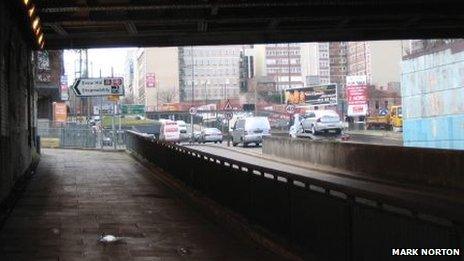
The tunnel - and roads leading up to it - in more modern times now have to cope with much more traffic

Looking along the same street but away from the city, many of the buildings have long since disappeared
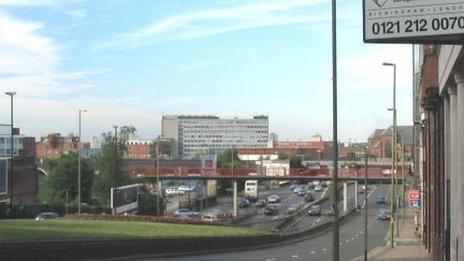
Car parks and unused land have replaced them

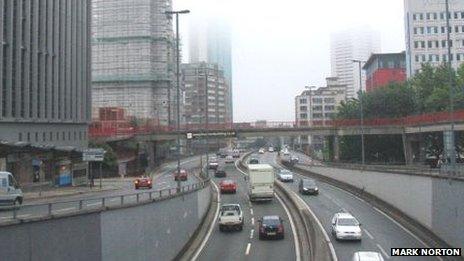
The road is now still surrounded by buildings but gets clogged up at rush hour as cars come in and out of the tunnels
When plans were first revealed for a ring road to surround Birmingham city centre, some might say the idea suited the times.
Herbert Manzoni, the city engineer and surveyor from 1935 until 1963, saw the route as a series of main roads linked by junctions, traffic islands and tunnels, cementing his view that "the car was king".
He started planning his concrete vision in 1943, and the damage to city during World War II gave him the chance to implement it.
But many buildings that survived being bombed by Nazi Germany did not escape Manzoni's plans, as the A4400 inner ringway was constructed throughout the 60s.
'Beautiful building demolished'
Some parts of the route have now been dismantled or made more pedestrian-friendly, but two of the main tunnels - the A38 St Chad's and Queensway tunnels - have shut for the next six weeks for essential repairs.
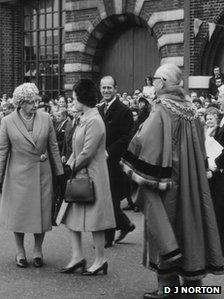
The Queen opened the inner ring road in 1971
Traffic used the inner ring road for the first time in January 1971, with the Queen and Duke of Edinburgh officially opening it in the April of the same year, author James Macmorran recorded in his Municipal Public Works and Planning in Birmingham 1852-1972.
Addressing the crowds, the Queen said the project had finished six years ahead of schedule - although she mistakenly named the full stretch of the route Queensway instead of just the intended half-mile section of the Queensway tunnel at Great Charles Street.
However, to get to this point, several "fabulous" buildings were demolished, said architect Jim Roberts, who designed Birmingham's Rotunda and who worked with Manzoni.
Lamenting their loss, he said: "It was: 'Let's have a ring road and that's where it's going to go' kind of thing.
"I had my practice in contemporary architecture and was doing lots of small little jobs around the city and he had no interest in architecture at all, old, new, nothing at all.
"He was instrumental in demolishing the Birmingham reference library which was by the Town Hall.
"It was a beautiful Victorian building, fabulously tall, which had escaped the bombings but didn't escape Manzoni's plans.
"If I'd had more knowledge at the time, I would have tried to save it because it was such a fabulous building."
Nick Corbett, an urban designer and chartered town planner based in Birmingham, said: "Another building that was knocked down was the Birmingham and Midland Institute, which included the Birmingham conservatoire, and was built by Charles Barry, and Bishop's Palace by Pugin [Victorian designer and architect].
"These guys designed the [present day] Houses of Parliament.
"St Chad's Cathedral was saved by just one vote when councillors voted on the plans."
Manzoni had a "zeal for modernist planning" although he started preparing his ideas from 1943, Mr Corbett said.
"He saw the car as king and heritage was not seen as worth preserving, but fashions and tastes change and Victorian buildings now are important."
By the late 80s, planners felt the need for a new, more pedestrian-friendly design strategy for the city.
The Highbury Initiative followed an international symposium which brought planners and architects from around the world to Birmingham.
'One continuous tunnel'
"This was the realisation that the city's so-called concrete collar [the ring road] was stifling growth as well as having a rather brutal appearance so work was started to set about dismantling it, which began with Masshouse Circus which was an enormous raised roundabout by Millennium Point," Mr Corbett said.
"It was about giving streets and squares back to the people and Victoria Square was also part of that and linking Brindley Place and Centenary Square.
The St Chad's and Queensway tunnels are the "last scars on the city" as the last major remaining sections of the ring road, he said.
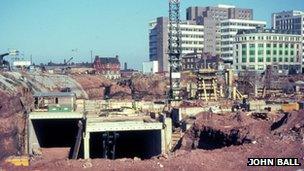
Building the Queensway tunnel was a major construction project in the city
He believes they should be made into one continuous tunnel to "stitch the city back together" by linking the Colmore Row business district with the Jewellery Quarter.
"I think contractor Amey [which maintains the city's roads] looked at the cost of that and said it would be £64m - a third of the price of the new library to put it into context.
"The city council might not have the funding to do this project, but it is a major landowner, and it could package its city centre assets into a regeneration company, and then working in partnership with the private sector, it could capture the uplift in values that the tunnel would bring. This way the tunnel could pay for itself."
When Manzoni's city vision was being implemented, Mr Corbett said there was very little public consultation with those in power knowing best.
"Had Manzoni listened to more people and looked at the social issues at the time, he would probably have acted differently and the city could have been very different."
- Published20 July 2013
- Published19 July 2013
- Published19 July 2013
- Published18 June 2013
- Published21 May 2013
- Published1 November 2012
- Published31 October 2012
- Published10 April 2012
- Published1 March 2012